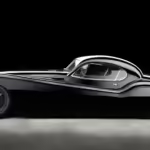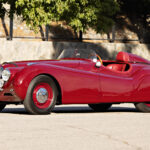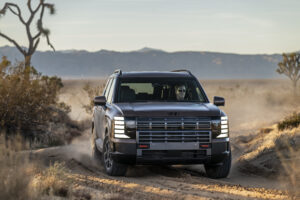Design Competition for a Futuristic Jaguar XK120 Inspired Concept


Futuristic 3D Surfacing Concept for a Luxury Sports Car Inspired by the 1950s Jaguar XK120
Our Vision
The design of the Jaguar XK120 from the 1950s is renowned for its elegant, flowing lines and sculpted curves, evoking a sense of speed and luxury. To modernize this aesthetic while integrating cutting-edge aerodynamic principles and sustainable materials, this concept would blend the timeless beauty of classic automotive design with the functionality required by today’s high-performance luxury sports cars.
The result is a futuristic 3D surfacing concept that preserves the XK120’s sensual and organic forms but sharpens and adapts them to optimize aerodynamic performance. Additionally, the surfaces are designed to complement the use of sustainable materials, such as lightweight carbon composites or recycled bio-based plastics, without sacrificing luxury.

Key Design Features
- Flowing, Organic Curves
- The core design DNA of the 1950s Jaguar XK120 is characterized by soft, sweeping curves that flow from front to rear, giving the car a sense of perpetual motion even when stationary. This aesthetic is preserved but enhanced with more refined and taut lines that suggest greater precision and modernity.
- The long, teardrop-shaped body with a low nose and raised rear fenders mirrors the XK120’s proportions, yet the curves are honed to create a dynamic, muscular stance.
- Integrated Aerodynamic Features
- Active Aerodynamics: While the XK120’s curves were largely for aesthetic purposes, this futuristic concept incorporates active aerodynamic features to optimize performance. Subtle surface articulations, such as retractable front splitters, rear diffusers, and side skirts, deploy automatically at high speeds to minimize drag and improve downforce.
- Sculpted Air Intakes and Vents: Unlike the XK120, which had minimal surface openings, this concept integrates aerodynamically efficient air intakes that are seamlessly embedded into the bodywork. These intakes guide air efficiently to cool the engine and brakes while maintaining the smooth, flowing aesthetic.
- Smooth Undercarriage: To reduce drag, the car’s underbody is designed to be completely flat, creating laminar airflow underneath. This is paired with an aggressive rear diffuser that channels air out to improve stability and reduce turbulence.
- Sharp Creases and Tension Lines
- The 3D surface is punctuated by sharp creases running along key areas like the hood, fenders, and rear haunches, which create an interplay between smooth surfaces and defined edges. These tense surfaces give the car a feeling of strength and power, while also improving airflow over the body.
- Front-to-Rear Tension Lines: Subtle ridges along the hood and roofline are shaped to guide airflow smoothly over the vehicle, reducing drag and improving fuel efficiency. These tension lines also visually connect the front and rear, making the car appear sleeker and longer.
- Sustainable Material Integration
- The surfaces are designed with sustainability in mind, leveraging lightweight materials such as recycled carbon fiber composites and bio-based plastics. These materials are environmentally friendly while maintaining the necessary rigidity and strength for high-performance driving.
- The car’s interior and exterior use a modular panel system, where individual body panels can be easily replaced or recycled at the end of the vehicle’s life cycle.
- A natural fiber composite could be used for non-load-bearing surfaces like the hood or trunk lid, offering a tactile, eco-friendly alternative to traditional metals or plastics.
- Minimalistic, Seamless Design Language
- The integration of new technologies, such as flush-mounted door handles and hidden sensors, enhances the vehicle’s seamless aesthetic. Traditional breaks in the surface are minimized, giving the car a clean, uninterrupted look.
- Glass-to-Metal Transitions: The glasshouse (windscreen, side windows, rear window) blends seamlessly with the body, aided by cutting-edge adhesive technology that eliminates the need for traditional weatherstripping and seals. This not only enhances aerodynamics but also contributes to the overall sculptural feel.

Impact on Driving Dynamics
- Improved Aerodynamics for Better Handling and Efficiency
- The flowing curves and tension lines work together to minimize drag while directing airflow efficiently around the vehicle. The smooth transitions and surface continuity reduce turbulence, improving fuel efficiency and range, especially for electric or hybrid models.
- Increased Downforce: Active aerodynamic elements, such as an adjustable rear spoiler and front splitter, allow the car to generate downforce at high speeds, improving cornering stability and handling without compromising the elegant aesthetic.
- Lightweight Materials for Enhanced Agility
- The use of lightweight carbon composites and sustainable materials reduces the vehicle’s overall weight, contributing to better acceleration, braking, and agility. This ensures that the car is as fast and responsive as its design suggests.
- Reduced weight also translates to increased efficiency, especially for electric or hybrid powertrains, enabling longer driving ranges and more agile performance in various driving conditions.
- Optimized Weight Distribution
- The 3D surfacing is designed to ensure that weight is distributed optimally across the chassis. The car’s center of gravity is low, helping to maintain stability at high speeds and during cornering. The lightweight yet strong materials allow for strategic weight placement, such as keeping the rear-end heavier to improve traction and reduce understeer.

Vehicle Perception: Sculptural Beauty Meets Modern Tech
- Timeless Aesthetic with Modern Precision
- By blending the organic, flowing lines of a classic car like the XK120 with sharp creases and modern aerodynamic surfaces, the vehicle evokes a sense of timeless luxury while also signaling that it is a high-performance, high-tech machine.
- The continuous and cohesive design language gives the car an almost sculptural, artistic quality—a luxury sports car that can be appreciated not just as a vehicle but as a work of art.
- Sustainability as a Luxury Value
- The use of eco-friendly materials in both the interior and exterior surfaces elevates sustainability to a core element of the vehicle’s design. For high-end buyers, this signals not just performance and aesthetics but a forward-thinking approach to luxury and environmental responsibility.
- Customers would view the car not only as a high-performance machine but as a statement of modern luxury, where design meets sustainability.
- Future-Oriented Technology in a Classic Form
- The vehicle’s active aerodynamics and seamlessly integrated technology (such as flush sensors, advanced driver assistance systems, and real-time airflow adjustments) contribute to the perception of the car as being at the forefront of innovation, despite its classic design roots.
- The blend of timeless curves with cutting-edge tech gives the car an aura of futuristic elegance, appealing to buyers who appreciate both traditional craftsmanship and the latest advancements in automotive design.
“Futuristic Elegance” Design Competition
Are you ready to shape the future of luxury automotive design?
We invite design enthusiasts, car design students, and professional designers to participate in the “Futuristic Elegance” Design Competition! This is your chance to reimagine a luxury sports car that blends the iconic, flowing curves of the 1950s Jaguar XK120 with cutting-edge aerodynamic principles and sustainable materials.
The Challenge:
Your task is to design a futuristic 3D surfacing concept for a luxury sports car that:
- Incorporates the flowing lines and organic curves of the Jaguar XK120.
- Integrates modern aerodynamic features to enhance the vehicle’s performance.
- Uses sustainable materials, aligning with the future of environmentally responsible automotive design.
- Explores how your surfacing design could influence driving dynamics, such as handling, speed, and stability, while redefining the perception of luxury.
Who Can Enter:
This competition is open to all:
- Design enthusiasts
- Car design students
- Professional designers
Whether you’re an aspiring student or a seasoned professional, this is an opportunity to showcase your creativity, technical skills, and forward-thinking vision for the future of automotive design.
Submission Categories:
Competitors can choose to be judged under the following categories:
- Design Enthusiasts
- Car Design Students
- Professional Designers
Submission Guidelines:
Participants can submit their concepts in any of the following formats:
- Sketches (hand-drawn or digital)
- Renderings and Illustrations
- 3D Models
- Animations (optional but encouraged)
Your work must be original and created specifically for this competition. You must own the rights to your proposal, and any third-party assets used must be properly licensed.
Submission Process:
To enter, email your submission to info@cardesigntv.com. Please include the following in your submission:
- Your design images (sketches, renderings, 3D models, or animations).
- A brief description (up to 500 words) explaining your design concept, including:
- The inspiration behind your design.
- How your design incorporates aerodynamic principles and sustainable materials.
- The potential impact of the surfacing on driving dynamics and vehicle perception.
- Your name, address, and age.
- The category (Design Enthusiast, Car Design Student, or Professional Designer) under which you wish to be judged.
Submission Deadline:
All entries must be received by Wednesday, December 16, 2024, at 12 Noon PST.
Judging Criteria:
Submissions will be evaluated based on:
- Creativity and originality in surfacing design.
- Effective integration of aerodynamic features to enhance performance.
- Thoughtful use of sustainable materials in the design.
- Influence of the surfacing on driving dynamics and vehicle aesthetics.
- How well the design captures the timeless elegance of the Jaguar XK120 while embracing futuristic technologies and principles.
Prizes:
Winning designs will be featured on Car Design TV’s platforms, gaining exposure to industry professionals, design enthusiasts, and leading automotive brands. Winners will also receive special recognition and a prize package designed to help further their design careers.
Get Creative and Inspire the Future!
This is your opportunity to fuse classic automotive elegance with modern-day innovations in surfacing and sustainability. Whether you’re a student with fresh ideas or a seasoned designer looking to push boundaries, we can’t wait to see how you envision the next generation of luxury automotive design.
Submit your designs by Wednesday December 16, 2024, at 12 Noon PST, and take your place in shaping the future of automotive design!




















